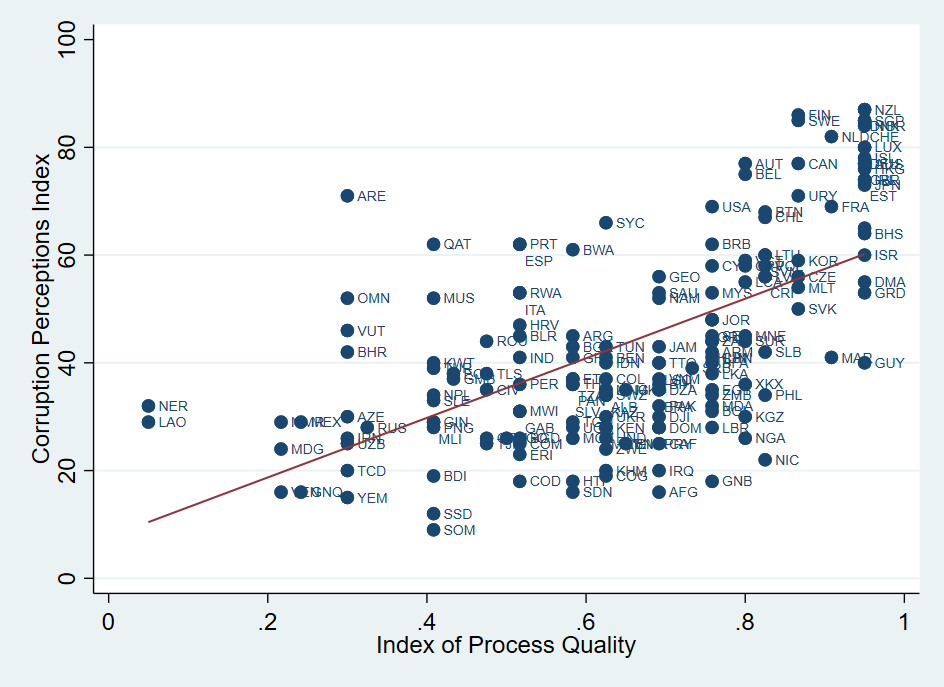 Customs controls on the border of Armenia
Customs controls on the border of Armenia
“Clean” public procurement – through a process that is transparent, accountable and efficient – is often considered the first step towards a government free of corruption. International organizations like the United Nations and the OECD are devising or promoting procurement regulation that limits the possibility of bribery in the awarding of public contracts. So are public-interest organizations like Transparency International. Their concern is warranted. The amount of money that governments spend each year on procuring goods, services and works is large – $11 trillion to be precise – raising the risk of corruption.
To test the relationship between clean procurement processes and corruption in general, we link a measure of corruption in government with perceptions of inefficient processes in public procurement (figure 1). The former measure is created by Transparency International, the most widely-used such measure in academic studies. The latter is a composite of three manifestations of irregularities in the procurement process – the presence of collusive practices, other non-competitive practices or favoritism in the awarding of contracts. These data have been collected in our ongoing research project with professors Edward Glaeser and Andrei Shleifer at Harvard University.
Figure 1: Clean procurement processes go hand in hand with clean government

Source: Doing Business database.
The scatterplot displays three patterns. First, the overall correlation is high, at 0.60, suggesting that countries with clean procurement processes like Estonia, Finland and France are also where the overall perception of corruption is low. Second, in countries below the trend line – for example Morocco and the Philippines – procurement is perceived to be cleaner than other aspects of public administration. This implies that one can learn from what works in public procurement and apply it elsewhere in public administration. Third, and conversely, some governments come across as cleaner overall than is manifested in the procurement process, for example the United Arab Emirates or Qatar. In such instances, politicians can improve procurement regulation to increase the perception of cleanliness.
There are other parts of government that often need cleaning: customs procedures or business license procedures, to name two that have been studied in the Doing Business project. While these activities are governed by different regulations and implemented by different agencies or levels of the administration, the rules of clean government apply too.
Help is on the way. Several initiatives have emerged to clean public procurement. The first initiative is the Integrity Pacts Program, developed by Transparency International. These pacts are signed between Transparency International and the government at the project level. They have been used worldwide in more than 300 contracting processes across a variety of sectors – from international airport construction and hydro-electric projects to land redistribution in Romania. Most recently, an integrity pact was signed with the Bulgarian government to monitor the construction of tunnels along the E79 motorway.
The second initiative is the OECD’s Methodology for Assessing Procurement Systems, implemented across the economy. This methodology assesses public procurement systems in their entirety. One of the main dimensions is clean awards of public contracts, including a focus on transparency. In an earlier blog, we show that transparency in procurement reduces bribes, much like the OECD suggests it would.
The United Nations’ model procurement law, adopted in more than two dozen countries, is a third example of a successful initiative. From Armenia to Uganda, the model law and accompanying Guide to Enactment have made for cleaner procurement processes. Our research supports this view: countries that have adopted the model law have seen a reduction in bribery.
It may seem that the plethora of initiatives causes confusion, as politicians struggle to decide which route to follow. Our data shows, however, that when it comes to achieving cleaner public procurement, the more cooks, the tastier the broth.



Join the Conversation